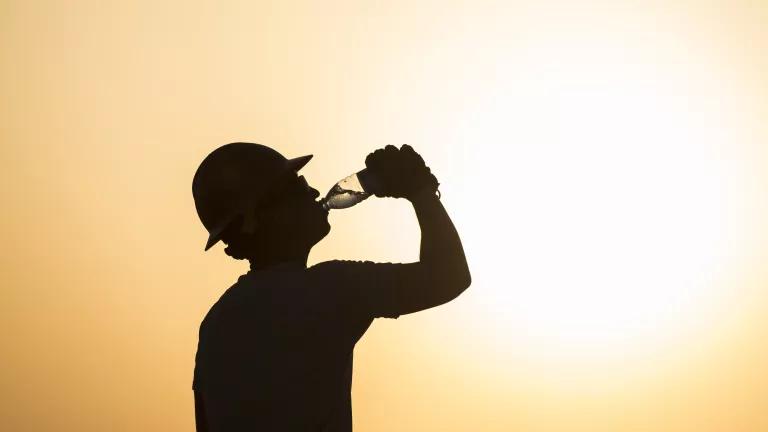Commonsense Solutions: Protecting Workers From Extreme Heat
Protecting workers from the growing dangers of soaring temperatures is vital and the solutions are out there to do so. Here are three important actions Congress and the administration should prioritize to protect our workers from extreme heat.

Airman drinking water at construction site
U.S. Air Force
Record-breaking heat waves are sweeping over the nation. This summer, heat warnings and advisories have been issued in 21 states and counting.
Workers are bearing the brunt of the heat: exposure to heat can reduce productivity, lead to loss of wages, and cause life-altering illnesses. Indeed, those who work in the searing heat are especially in danger because heat can, and does, kill people. And yet, this is entirely preventable.
Protecting workers from the growing dangers of soaring temperatures is vital and the solutions are out there to do so. NRDC’s new report, On the Front Lines: Climate Change Threatens the Health of America’s Workers, highlights several ways in which we can protect workers from climate-fueled extreme heat.
Here are three important actions Congress and the administration should prioritize to protect our workers from extreme heat.
Solution #1: A federal heat stress standard
Health problems linked to extreme heat are notoriously undercounted. But since 1992, heat has killed more than 780 US workers, and made tens of thousands more sick or injured.
Unfortunately, there is no federal heat stress safeguard to protect workers. California, Washington, and Minnesota have passed state-level heat standards to protect workers there, but health protection shouldn’t be limited by geography. It is time for a federal standard that bolsters protection from the effects of heat for every worker. A heat standard can also provide long-term economic benefits by potentially reducing costs to workers and employers that are associated with heat-related illnesses, including absenteeism and productivity loss.
In 2016, the National Institute for Occupational Safety and Health (NIOSH) published criteria recommendations and best practices for a national heat standard that has not yet been adopted. The Occupational Safety and Health Administration (OSHA) should establish an enforceable heat stress standard based on this body of recommendations that protects both indoor and outdoor workers. These science-based recommendations have been supported by unions and worker advocate groups. Additionally, in their recent Climate Crisis Action Plan, the House Select Committee on the Climate Crisis has also called for a heat safety standard to be enacted. The science is clear—now, we need to put that science into practice to protect workers.
Solution #2: Safer public infrastructure
Time and time again, employees have had to spend their own money on workplace safety protections. While OSHA requires employers to maintain a workplace that is free from hazards and to provide personal protective equipment, many workers are still not being protected from heat. For example, some of the nation’s largest school districts are not fully air-conditioned, and teachers across the country have resorted to buying fans and window units with their own money to cool their classrooms. As schools begin to reopen, teachers will now face an added stress of wearing personal protective equipment in classrooms that do not provide adequate cooling and ventilation.
A lack of adequate cooling and ventilation in our public infrastructure leaves workers even more vulnerable to heat-related illnesses. We need to assess and update building systems in schools, hospitals, and other public infrastructure. Our inadequate infrastructure funding costs us money and jobs. To get this done, we need our policymakers to provide significant increases in funding levels and opportunities for public infrastructure investments. This funding can be used for much-needed updates such as cooling systems in our public schools.
Solution #3: A coordinated approach to occupational health and safety tracking
Tracking of heat-related illnesses and deaths remains limited, due to a systemic lack of comprehensive and coordinated reporting. In addition, the data we do have is scattered and inconsistent from place to place, weakening our understanding of climate-related occupational health injuries and illnesses.
We can improve worker health with a comprehensive system to gather, organize, analyze, and interpret the occupational health data. Such a system would help health professionals better understand the underlying drivers of occupational illnesses, injuries, and deaths, and would be an important tool to understand the link between climate change and worker health. The Bureau of Labor Statistics (BLS) and the Centers for Disease Control and Prevention (CDC) should work directly with the Office of Personnel Management to develop and maintain such a system, and the database should be publicly available.
The takeaway
As the oppressive heat continues to bear down on the U.S., science-backed safeguards must be put in place to protect those who are hardest hit by heat. We need federal protections that cover every worker. We need funding for public infrastructure that reduces heat hazards in workplaces. And we need a centralized system that synthesizes occupational health data so that we can properly understand the challenges we are facing, and develop climate-resilient solutions that better protect our communities.
In the face of growing climate-threats, every worker has the right to go to work and to return home safe and healthy.



